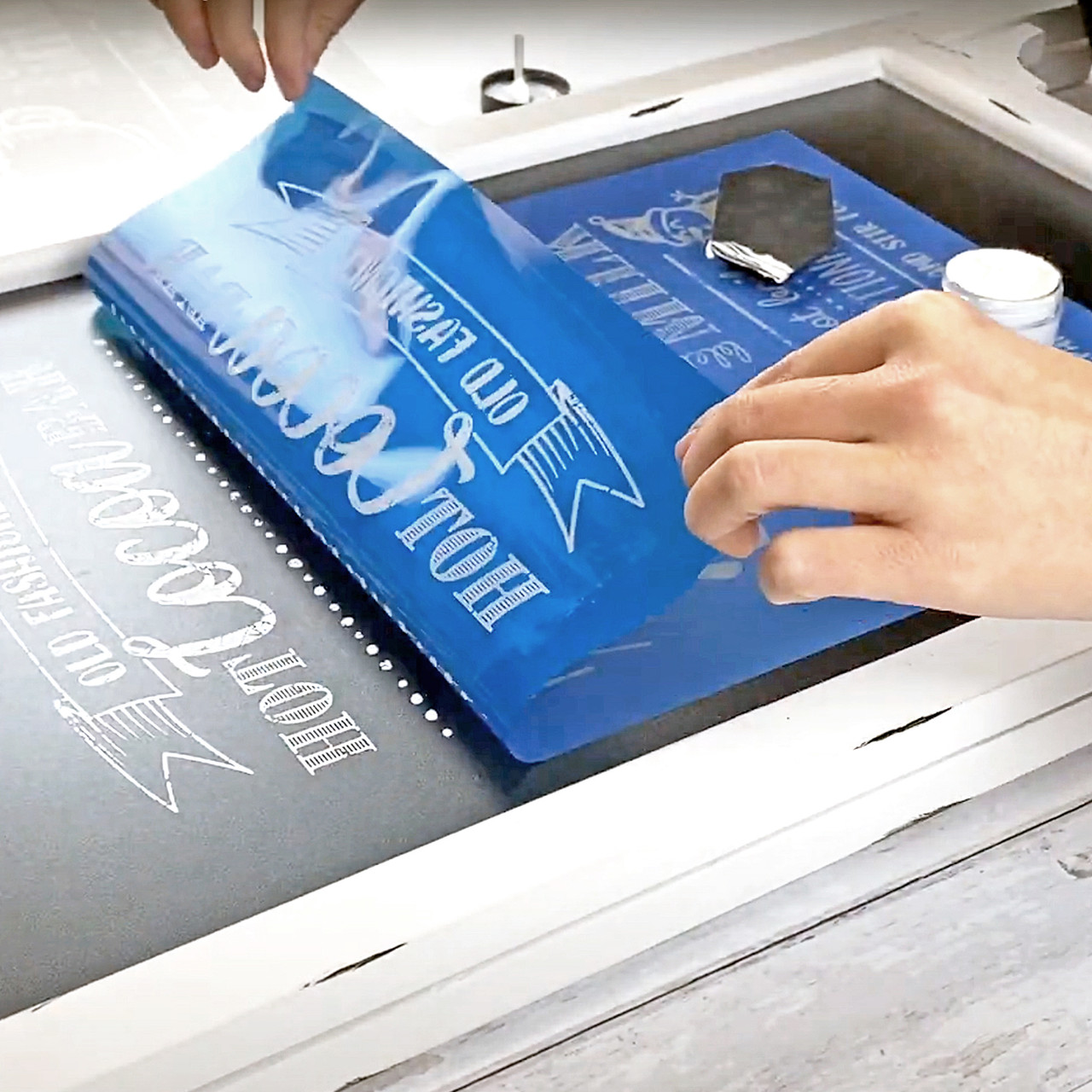Creative T-Shirt Printing Ideas for Small Brands
Creative T-Shirt Printing Ideas for Small Brands
Blog Article
Display Printing Uncovered: Everything You Need to Learn About Tee and Garment Printing Methods
If you have actually ever before wondered just how those lively designs wind up on your preferred tees, you remain in the right place. Screen printing is a fascinating approach that incorporates art with method, supplying limitless possibilities for creative thinking. Understanding the principles, from equipment to ink selections, can substantially affect your results. All set to explore the vital components that make screen publishing an art form? Let's uncover the information that can elevate your projects.
The Essentials of Display Printing: How It Works
When you plunge right into screen printing, you'll discover it's both an art and a scientific research. At its core, screen printing involves producing a stencil, or display, that enables ink to pass via just in specific locations.
Position the screen over the material, then make use of a squeegee to press ink via the screen onto the garment. Each step is essential, and understanding them will boost your display printing abilities, changing basic garments into distinct, expressive items.
Sorts Of Screen Printing Methods
As soon as you grasp the fundamentals of screen printing, it's time to discover the different strategies that can elevate your designs. One preferred approach is traditional screen printing, where ink is pushed with a stenciled screen. This strategy is excellent for bold, lively shades. After that there's water-based ink printing, which offers a softer feeling and is environment-friendly, but it calls for a different approach to treating.
If you're going for fine details, take into consideration discharge printing. This technique eliminates color from the fabric, leaving a soft, classic look. Another choice is plastisol printing, understood for its longevity and dazzling colors, making it a favored for lots of brand names. Lastly, trying out halftone printing to produce gradient results and intricate layouts. Each technique has its unique appeal, so do not hesitate to attempt them out to find what matches your style best!
Important Tools for Display Printing
To attain magnificent results in display printing, having the right tools is basic. You'll need a strong display printing frame, which holds the mesh that transfers your style onto the garment. Next, invest in high-quality squeegees; these are vital for applying ink uniformly throughout the display.
Choosing the Right Inks and Materials
When choosing inks and materials for display printing, you need to consider the sort of ink that works best for your job. Consider textile compatibility to guarantee your styles look terrific and last lengthy. Discover green ink alternatives to make your printing process extra sustainable.
Kinds Of Display Inks
Selecting the ideal display ink is necessary for achieving vibrant, long lasting prints that meet your task's requirements. There are numerous kinds of display inks to check out. Specialized inks, such as metal or glow-in-the-dark, can include one-of-a-kind effects to your styles.

Fabric Compatibility Factors To Consider
Comprehending textile compatibility is vital for attaining premium display prints, especially since various products react distinctly to different inks. When selecting inks, take into consideration the fabric kind-- cotton, polyester, or blends. For cotton, water-based inks function well, supplying gentleness and breathability. Polyester, on the other hand, frequently needs plastisol inks for far better bond and lively shades. If you're printing on blends, you may need to make use of a mix of both types. Always evaluate your inks on sample fabric to ensure they stick properly and keep shade honesty. Furthermore, keep in mind that textile weight and texture can impact the final outcome, so choosing the appropriate ink and product combination is crucial for your project's success.
Eco-Friendly Ink Options
Environment-friendly inks are ending up being a preferred option for display printers who wish to minimize their ecological influence while preserving high quality. When choosing inks, take into consideration water-based inks, which are much less dangerous and much easier to tidy up compared to conventional solvents. These inks bond well with materials, supplying dynamic results without poisonous chemicals. You could also discover eco-solvent inks that use less unpredictable natural substances (VOCs), making them a much safer option for both your health and wellness and the world.
Furthermore, try to find inks made from renewable energies, such as soy or vegetable-based alternatives. By picking the ideal inks and products, you'll not just produce magnificent designs but also add to a much more lasting printing procedure. Make the switch, and your prints will reflect your dedication to the setting!
Preparing Your Layout for Screen Printing

File Format Needs
To guarantee your layout looks dynamic and sharp on textile, you'll require to pay close focus to file layout requirements for screen printing. Make certain your layout has a transparent background to avoid unwanted white edges on your prints. Maintain color settings in mind; CMYK is basic for screen printing, so convert your RGB makes appropriately.
Shade Separation Techniques
Color separation is a crucial step in preparing your design for display printing, and understanding it can greatly enhance your print quality. You'll require to damage your layout right into specific shades, as each shade calls for a separate screen during printing. Beginning by identifying all the shades in your layout and produce layers each. You can use software program like Adobe Photoshop or Illustrator to isolate and separate shades effectively. Be specific to save each layer as a different data, usually in a layout like TIFF or PSD. This precision not just assures exact shade depiction but additionally streamlines the printing process. By taking note of shade splitting up, you'll accomplish dynamic and specialist cause your screen-printed garments.
Resolution and Dimension
Accomplishing the most effective cause display printing starts with ensuring your design has the appropriate resolution and dimension. Ideally, your art work ought to be at least 300 DPI (dots per inch) for sharp, clear prints. Your final item might look pixelated and unprofessional. if you utilize lower resolution.
When it involves size, consider the dimensions of your print location. Style your art work to match the final print size, preferably producing it in the real measurements you'll be printing. In this manner, you'll stay clear of any unanticipated scaling issues.
Constantly inspect your style in both vector and raster layouts. Vector graphics can be scaled without losing top quality, making them ideal for screen printing. Preparing appropriately will guarantee your layout looks amazing on every garment!
Step-by-Step Screen Printing Refine
Screen printing is a vibrant process that enables you to develop vibrant designs on various surface areas. To start, you'll need a screen, solution, and your selected ink. First, prepare your display by cleansing it extensively. Next, use the solution equally and allow it dry in a dark area. When completely dry, reveal your display to light with your style positioned on it, which will harden the solution where the light hits, developing a pattern - screen printing kit.
Pour ink onto the display and make use of a squeegee to press the ink through the stencil onto the material. Raise the display meticulously and allow the print completely dry. You've efficiently display published your style.
Tips for Effective Screen Printing Projects
While you're diving right into your display printing tasks, keep in mind that preparation is crucial to success. Beginning by collecting all your materials-- inks, squeegees, garments, and screens. A tidy work space helps protect against undesirable errors, so clean prior have a peek here to you begin.
Following, validate your art work is high-resolution and properly sized for your garment. Examine your screen for appropriate exposure and clean it extensively to prevent smudges. When mixing your inks, follow the maker's guidelines to attain the best uniformity.
During printing, apply also pressure with your squeegee for regular outcomes. Do not rush; take your time to confirm each print satisfies your standards. After printing, allow your garments dry totally before managing or packaging them.
Finally, always keep an example of your benefit future referral. This method, you can examine your progression and enhance your methods over time. Delighted printing!

Often Asked Concerns
How much time Does It Require To Establish a Display Printing Work?
Setting up a screen printing task typically takes about thirty minutes to an hour. You'll prepare the screens, mix inks, and readjust the press. The moment varies based on complexity and experience, so remain arranged!
Can I Publish on Various Textile Keys In Utilizing the Exact Same Strategy?
Yes, you can print on different material types making use of the same technique, but you'll require special info to readjust your setups and inks. Some fabrics absorb ink in different ways, so trying out warranties the most effective outcomes for each product.
What Are Common Blunders to Stay Clear Of in Screen Printing?
When screen printing, avoid usual errors like using the incorrect ink, disregarding appropriate exposure times, or avoiding pre-press checks. Always evaluate your arrangement and maintain tidy screens to guarantee top quality results each time.
Exactly How Can I Effectively Tidy and Preserve My Display Printing Equipment?
To appropriately clean and preserve your display printing tools, you need to consistently wash displays with appropriate solvents, examine mops for wear, and guarantee all devices are saved dust-free and completely dry. Uniformity protects against expensive repairs and boosts efficiency.
Is Screen Printing Eco Friendly Compared to Other Techniques?
Screen printing can be extra environmentally friendly than other techniques, particularly if you utilize eco-conscious products and water-based inks. By selecting lasting materials and techniques, you minimize waste and minimize your influence on the earth.
Screen Printing Uncovered: Everything You Need to Know About T-Shirt and Garment Printing Strategies
At its core, screen printing involves producing a pattern, or display, that allows ink to pass with only in certain areas. Placement the display over the material, then make use of a squeegee to press ink via the display onto the garment. One prominent technique is conventional screen printing, where ink is pressed through a stenciled screen.When choosing inks and materials for display printing, you need to take into account the type of ink that functions best for your project.
Report this page